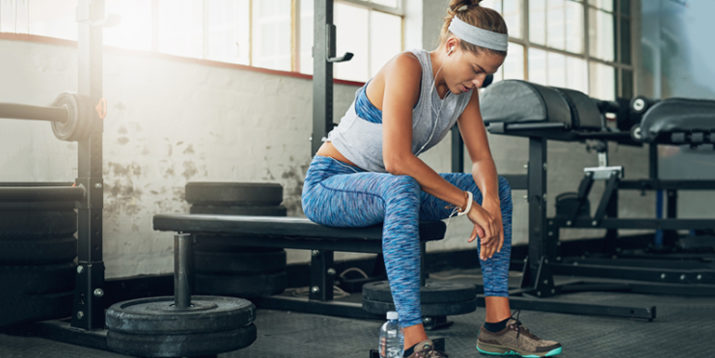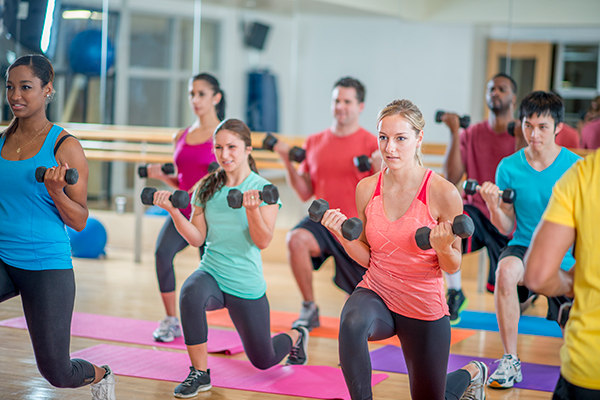10 Reasons Why You Hate Working Out

It’s difficult to start an exercise program, much less stick with it long term. Between busy work weeks, happy hours, and a general lack of exercise motivation, it’s easy to find reasons to skip a workout… but that can lead to a vicious cycle. “The more we don’t [exercise] and the less fit we become, the worse it feels to work out,” says Abigail Lufkin, a clinical therapist and sports psychology consultant in Santa Monica, California. And once you get it in your head that you hate working out, it’s hard view exercise as anything other than a punishment.
To begin shifting your mindset, nail down what’s motivating you to exercise. “Is it to lose weight, to feel better, to feel stronger, to be healthier? Find the thing that drives you to even consider exercising and focus on that,” she says.
If you’re struggling to come up with a definitive reason, Lufkin suggests setting a SMART goal, which stands for Specific, Measurable, Attainable, Relevant, Time-Bound. SMART goals help make the task of getting fit less daunting by breaking it down into smaller, actionable pieces and giving you a clear vision of why you’re doing what you’re doing. When you have the right kind of exercise motivation, staying committed to working out — and actually enjoying it — is possible.
Below is a rundown of some of the most common reasons people hate working out, and how to overcome them to increase your exercise motivation.
Why You Don’t Like Working Out and How to Improve Exercise Motivation
Why you hate it: It’s boring.
Solution: For some people, there’s nothing worse than running. Others hate swimming. And still others would rather watch paint dry than lift weights at the gym. That’s why it’s important to try a variety of exercise styles to find what most appeals to you. “There are a ton of different types of workouts that appeal to all types of people,” explained Holly Janiszewski, NASM-CPT and a Twin Cities-based personal trainer. “If you think exercise is boring, my biggest piece of advice is to try something new.”
A personal trainer can help you find interesting ways to get moving, or you can head to Beachbody On Demand for a selection of more than 40 different workout programs for all fitness levels — they cover everything from weightlifting to yoga. Check out this guide to get an overview of our most popular options.
Why you hate it: It’s not fun to work out alone.
Solution: Whether it’s talking on the phone or playing chess, some things are just better with another person. The same can go for exercise. A good workout buddy can boost your enjoyment, and studies show that it can even encourage you to exercise more often. When it comes to working out, being accountable to another person can also go a long way toward keeping you on track with your schedule, Lufkin says.
Working out in a group can multiply the benefits — especially when it comes to exercise enjoyment. Need help finding a group? Beachbody offers a variety of live classes in locations across the country that cater to all fitness levels.

Why you hate it: It’s exhausting.
Solution: When you get home from a long day at work, all you want to do is plant your butt on the couch; trying to summon enough energy to exercise is the last thing on your mind. But research shows that physical activity can increase energy levels rather than sap them. Working out could be just what you need to have a productive end to your day.
But if you just can’t pick yourself up in the evening, pick a time of day to work out when you’re typically more energized, and when you can work out consistently. That last part is key. As the saying goes, “the best time to work out is the time when you will work out.”
Why you hate it: You’re afraid you’re going to fail.
Solution: Sometimes it feels easier to avoid a task altogether than it is to risk falling short of your goal. If you never start trying to lose weight, then you can’t fail at it, right?
This is why SMART goals are key: They help you work toward something you can actually achieve. “It’s important to set small, attainable goals, and celebrate when you meet them,” Lufkin says. Acknowledging your success can be a huge step forward in making the workout plan more enjoyable. When you hit a goal, treat yourself to something fun that aids your progress, like new workout clothes or a massage.
Having a support system can also help you overcome a fear of working out. Instead of feeling like you’re attacking a daunting task alone, a workout buddy or online community can give you the extra encouragement you need.
Why you hate it: You don’t like getting sweaty.
Solution: If you can’t work out before you prepare for your day, getting sweaty and ruining your hair and makeup can be a major deterrent to exercise. Unfortunately, to lose weight or gain strength, you’ll need to put in some hard work and get sweaty at some point. To avoid having to redo your coiffure and curls, time your intense workouts to the beginning or end of your day.
Fortunately, you don’t have to subscribe to a gut-busting, sweat-inducing workout every single day. There are low-impact and low-intensity exercises that can give you a decent calorie burn without significant schvitzing. Try activities like hatha yoga, Pilates, or even walking. Research suggests that you can gain major health benefits from a simple 30-minute walking routine. It’s enough to get your heart rate up, but won’t leave you soaked and smelly.
If you really, really hate the sticky feeling of sweat, head to the pool and try a swim workout. It will give you an intense, total-body cardio workout without having to feel sweat dripping down your face. Of course, you’ll now have to contend with chlorine — and a shower will still be in your very near future.
Why you hate it: It takes up too much time.
Solution: Whether you have a demanding job, no childcare, or both, it can be a challenge to find time to exercise. To get over this hurdle, Lufkin recommends starting small, and making exercise a nonnegotiable must-do. “Start with 15 minutes — anyone can find 15 minutes in their day — and schedule it like you would lunch with a friend [or a recurring business meeting],” she says. In short, start treating exercise like a key part of your day instead of a perpetual afterthought.
“You can even break up your workout if you aren’t able to find a time to get everything done at once,” Janiszewski adds. You might do half of it during lunch and the other half after work, for example. You don’t have to work out for very long to notice a benefit (research shows that even a few minutes of intense exercise per week can improve cardiovascular fitness), but you do have to be consistent.
Why you hate it: You can’t afford or don’t want to pay for a gym membership.
Solution: Access to workout facilities and equipment can play a major role in sticking with a workout routine. So why add extra obstacles like a gym membership or tons of gear into the mix when they’re not necessary? “There are many workouts that don’t require any equipment and can be done in a living room,” Janiszewski says. Just look at Beachbody On Demand‘s extensive exercise library, which includes more than 600 fat-blasting workouts that can be done in a six-foot-by-six-foot area — many of them (like CORE DE FORCE) requiring nothing more than your own bodyweight. Not only does working out at home save you the money of a gym membership, it also let’s you exercise on your own time.

Why you hate it: It’s embarrassing to work out in front of other people.
Solution: Exercise is supposed to relieve stress, not contribute to it. If you make yourself work out in an environment where you feel judged, it’s likely you won’t stick with it. “Choose activities and places where you feel the most comfortable,” Lufkin says. This is a big reason why at-home workouts are so appealing. Being able to exercise in the privacy of your own living room removes the fear of being judged by others. It also allows you to slow down and learn new exercises at your own pace, instead of feeling pressured to do it right the first time.
Why you hate it: You’re really out of shape.
Solution: The first few days or weeks of a new exercise program are often the hardest. Even when you do muster the energy to work out, new moves often leave you feeling tired and sore in places you didn’t even know existed. To avoid this, take steps to prevent muscle soreness so you don’t get discouraged. Start slowly, and gradually increase your effort and intensity based on how you feel after each successive workout.
What you eat after working out can also optimize your recovery and help prevent soreness. Beachbody Performance Recover is made with 20 grams of protein to aid muscle repair and growth, and it contains pomegranate extract, which has been shown to reduce muscle soreness.
Additionally, Janiszewski emphasizes the importance of listening to your body and scheduling rest and recovery days when needed. “Allowing time to recover after exercise is extremely important,” she says. “For example, if you do a heavy leg day, allow [those muscles] two days to fully recover.”
Why you hate it: It’s all just too overwhelming.
Solution: The sheer volume of fitness advice out in the world can be incredibly intimidating. That’s why it’s vital to not overcomplicate the process of getting started. “Tune into yourself and what you want. Think about what sounds like fun and give it a try. If possible, find a friend to do it with,” said Lufkin. “Most importantly, just do something — a walk around the block is better than no walk at all. Make the commitment to add a little more movement in your day and grow and build on that.” Check out some of our best beginner tips for getting fit to kickstart your fitness journey.
